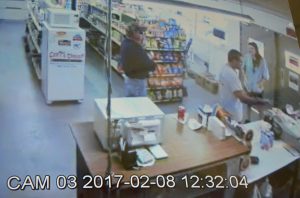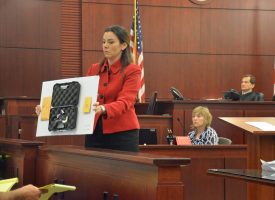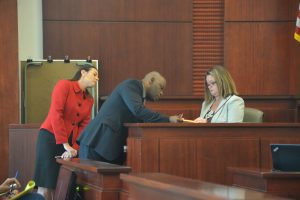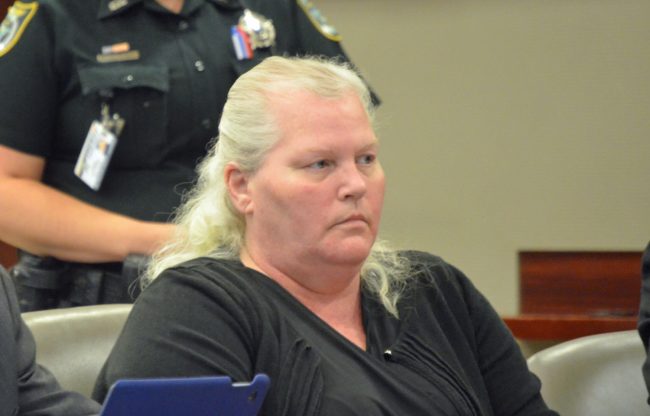!['This part here is the entrance of [where] the bullet punched in,” Predrag Bulic, the chief medical examiner of the Seventh Judicial District, who conducted the autopsy of Charles Singer, told the jury in the trial of Dorothy Singer, who is accused of murdering her husband. He was shot five times, four times in the head. She said at the defense table, without looking at the screen. (c FlaglerLive)](https://flaglerlive.com/wp-content/uploads/bulic-gunshot-650x431.jpg)
When Charles appeared in a February 8, 2017 transaction at Cody’s Corner, the convenience store at the southern end of the county on State Road 11, it was the first time–and likely the last time–the jury got to see the victim when he was alive. He was killed either that day or the next. In the video, he goes about buying a few goods, including his lunch, which he seasons with salt and pepper. He takes his time preparing his food and paying, then walks out.
The video was played on three oversize screens around the courtroom and smaller screens immediately in front of jurors, the judge or in the witness box. Charles’s mother, sitting next to her daughter and holding her hand in the first row in the courtroom audience, cried as she watched.

Dorothy Singer sat a few feet away from one of the screens. She never looked up. As she has since the trial began Monday, she kept her head tilted toward a yellow legal pad. She doodled impassively, her pen making short strokes over and over. There were rare exceptions. One of them was when the surveillance video showed her in a transaction at a Palatka Walmart, using Charles’s bank card, after the killing. She looked up when the prosecutor said she was about to be seen walking out of the store. Dorothy locked her eyes on the screen, waited, then saw herself in one of her last days of walking free. She then went back to doodling.
Dorothy herself cried though on at least two visible occasions. She cried at length when Lainie Rittenour, the sheriff’s crime-scene investigator, read out loud the three-page handwritten letter Dorothy had written the day of her arrest. She’d written it for Annie Conrad,the sheriff’s detective, and left it on on her car’s (Dorothy’s) dashboard, making it seem like a suicide note. Dorothy describes how Charles that fatal night dragged her into the back yard and threatened to shove her into a hog pen on their property, how he’d fired one round at her feet, how they struggled, how the gun went off and the bullet struck his chest, and how she blacked out. She then recalled sitting by his head and firing bullets into Charles’s head until the bullets ran out, and wrapped him in a blanket and placed him under a jon boat nearby.
In the letter, she claims she’d recalled hardly any part of the confrontation until a FlaglerLive article related to his disappearance and his body’s discovery caused her to have flashbacks, pushing her to attempt to escape: more precisely, to fake her death to a “safe house,” according to her sister, Tracy Harmon. “She was going to leave the state. All I know is she was going to fake her death” by abandoning her car, Harmon said in the stand.
To the prosecution, the letter was just another subterfuge, the latest in a three-month-long weave of fabrications to evade responsibility for the killing.
The video of Charles alive was played during today’s morning session, the second full day of the prosecution’s case in Dorothy Singer’s first degree murder trial. The footage was to contrast with what the prosecution showed afterward: pictures of where Charles was found in the backyard of his home, where Dorothy had buried him in a shallow grave and covered him up in a tarp, debris, moth balls and a jon boat. Intentionally or not the prosecutor displayed the pictures with the sort of progression that heightened the grimness of the discovery, even though jurors knew all along what was going to be discovered. After showing the pastoral surroundings of the Property the Singers rented on the west side, it’s green expanses of grass, trees and brush under a radiant sky, pictures then shifted to the burial from a distance, then up close as the boat and brush were removed, as the ground was removed, and as Charles’s very decomposed body appeared, first with his uncovered foot just past the tarp.
He had been placed there on his back–with a pillow under his head (a detail either pointing to Dorothy’s cynicism or regret the defense will possibly use to suggest less than malice when Dorothy killed him. The three months that would follow veered more toward cynicism).
There was also a picture of the shallow grave after the body had been removed. The ground was marked by a dark, muddy-black streak of decomposed matter. That was the other time Dorothy Singer was glimpsed catching sight of the screen in the courtroom. She was seen removing her glasses and apparently wiping a tear, an emotional echo of what she had told someone on May 7, 2017, the day of her arrest, three months after killing Charles: that it was her fault she had put herself in such a bad situation.

The prosecution showed the jury many more pictures. With the couple of exceptions of Charles’s decomposed body, which caused some of his friends or family members in the courtroom to put down their head, the pictures were not graphic–not recognizably so, anyway. They were the bleached, forensic work of the medical examiner’s autopsy: close-ups of the holes the small-caliber bullets had caused in the skull, an X-ray image showing a bullet still in what was left of Charles’s chest cavity, seven ribs, or segments of ribs, arrayed in semi-circles against a dark background. The point of Assistant State Prosecutor Jennifer Dunton’s questions to Medical Examiner Predrag Bulic was to illustrate how Charles was shot methodically at “very, very close” range, in Bulic’s words.
What the medical examiner could not determine was where Charles was shot, an important point for defense attorney Junior Barrett. Barrett spent his portion of the day questioning the medical examiner and a Florida Department of Law Enforcement analyst in such a way as to rule out a key assumption by the prosecution: that Charles was shot in his bedroom. The FDLE analyst noted blood elements in the bedroom, on the carpet, on a curtain and on the bed’s headboard, but not on the mattress or anywhere else.
The double-wide trailer where the Singers lived–and where Dorothy’s daughter and the daughter’s boyfriend came to live after Charles’s death–could have undergone many changes in the three months between Charles death (which Dorothy placed on Feb. 10, 2017, in her letter to Conrad) and her arrest exactly three months later.
Barrett contends the shooting never took place in the bedroom but rather outside by the hog pen, as Dorothy claims, and where Dorothy acted in self-defense.
And for the first time in three days, Barrett made some headway on that theory.
Barrett asked Bulic if it was reasonable to think the shot to the chest could have occurred during a struggle.
“Oh yes, absolutely,” Bulic said.
A juror asked whether the medical examiner could determine the sequence of the five shots. The question was revealing: at least one juror was following Barrett’s narrative. Bulic said no, then elaborated: the only way Charles could have been shot three times in the top of the head was if he was horizontal first. What got him there? “Either the one in the temple or the one in the chest came first, unfortunately I can’t tell you which one came first,” Bulic said. On the other hand, he could have also been shot three times on top of the head first–if he’d been asleep (as the sheriff’s detectives contend), and then shot in the chest or the temple.
The bullets in the head were never recovered. And the medical examiner could not determine where the shooting took place, or what the circumstances were beyond the range of the shots.
Barrett put the testimony of Harmon–Dorothy’s sister, a state’s witness–to his client’s benefit when he asked Harmon to speak of instances of alleged violence by Charles against Dorothy.

“She had her hair pulled out of her scalp” and had a “huge cut down on the back of her calf” in February, the month when she killed Charles, Harmon said. And in 2013, Harmon said she witnessed Charles “kicking, stomping her on her kidneys,” when Dorothy was getting cancer treatment, and says he “grabbed her by the hair” until she (Harmon) got him to stop. That was when Charles and Dorothy were dating, before their marriage.
But the prosecution then had Singer’s and Harmon’s mother on the stand. Singer had claimed to have sent her mother pictures of her injuries sustained at Charles hands. That turned out to be another lie. When the prosecutor asked her mother about those pictures, she said she didn’t have any nor had received any. “I’d be the last one” she’d send them to, she said.
There was one other key disparity between what Dorothy claimed happened, and the number of bullets in Charles’s body: she had claimed in her letter that he’d fired a shot at her feet when he was bullying her into the hog pen. But the revolver allegedly used only fires five shots–and five bullet holes were found on Charles’s body. To the defense’s advantage, an FDLE analyst who tested the gun could not with absolute certainty ascribe the bullets that were found in Charles’s body to the revolver in evidence, though the lack of certainty was slight.
Another analyst noted that the handgun had been cleaned before being submitted for analysis–presumably by either Singer sisters, as Dorothy had borrowed the gun from her sister and returned it after the shooting–making it unfit for DNA analysis.
Th gun is playing an important role for the prosecution aside from the obvious: Dorothy claims to have borrowed the gun from her sister because she felt unsafe in her west Flagler home when Charles traveled. But she had borrowed the gun months before the shooting, then returned it weeks afterward, without acquiring a different gun of her own, which undermines the earlier claim. And there was a rifle in the house all along.
In his brief opening argument Monday, Barrett had told the jury that, while the defense conceded that Dorothy had killed Charles, she had not done so with pre-meditated intent. What he has yet to overcome is the relentless premeditation of Dorothy’s lies and coverup after the killing.
The morning session had revealed yet more conversations with Dorothy detectives had recorded, without her knowledge, as they spoke with her about Charles’s alleged disappearance. As in previous such recordings, Dorothy portrayed herself as the victim of Charles’s meanness and manipulations, accusing him of making up a story about his disappearance just to be mean to her, among other accusations.
Along the way though Dorothy made several statements that, knowing what detectives would soon learn, stand out for their mixture of mordancy and mockery: “If you were to come tell me you found him dead, yeah, I would cry, I’d be hurt,” she told detectives Annie Conrad and Jodie Glasgow. And: “I appreciate everything you do. I’m glad that you’re all searching my place and know, I have nothing to hide.” When others had told her they thought she and Charles were getting divorced, “so did I,” she’s heard saying, because he’d become so “mean and hateful,” she said. “And now he’s missing.”
She also claimed to “hate drama.”
“If we get anything good, we’ll definitely let you know,” Conrad told her.
The next time Dorothy saw the detectives was when they served a search warrant on the property, and unearthed Charles.
The trial was scheduled for four days, including jury selection last Monday. By day’s end today, the prosecution had still not rested–it had two more witnesses set for Friday morning–raising the possibility that the trial might not end Friday. But the prosecutor said the case may go to the jury by lunchtime Friday.
![]()





























Anonymous says
She looks stone cold.